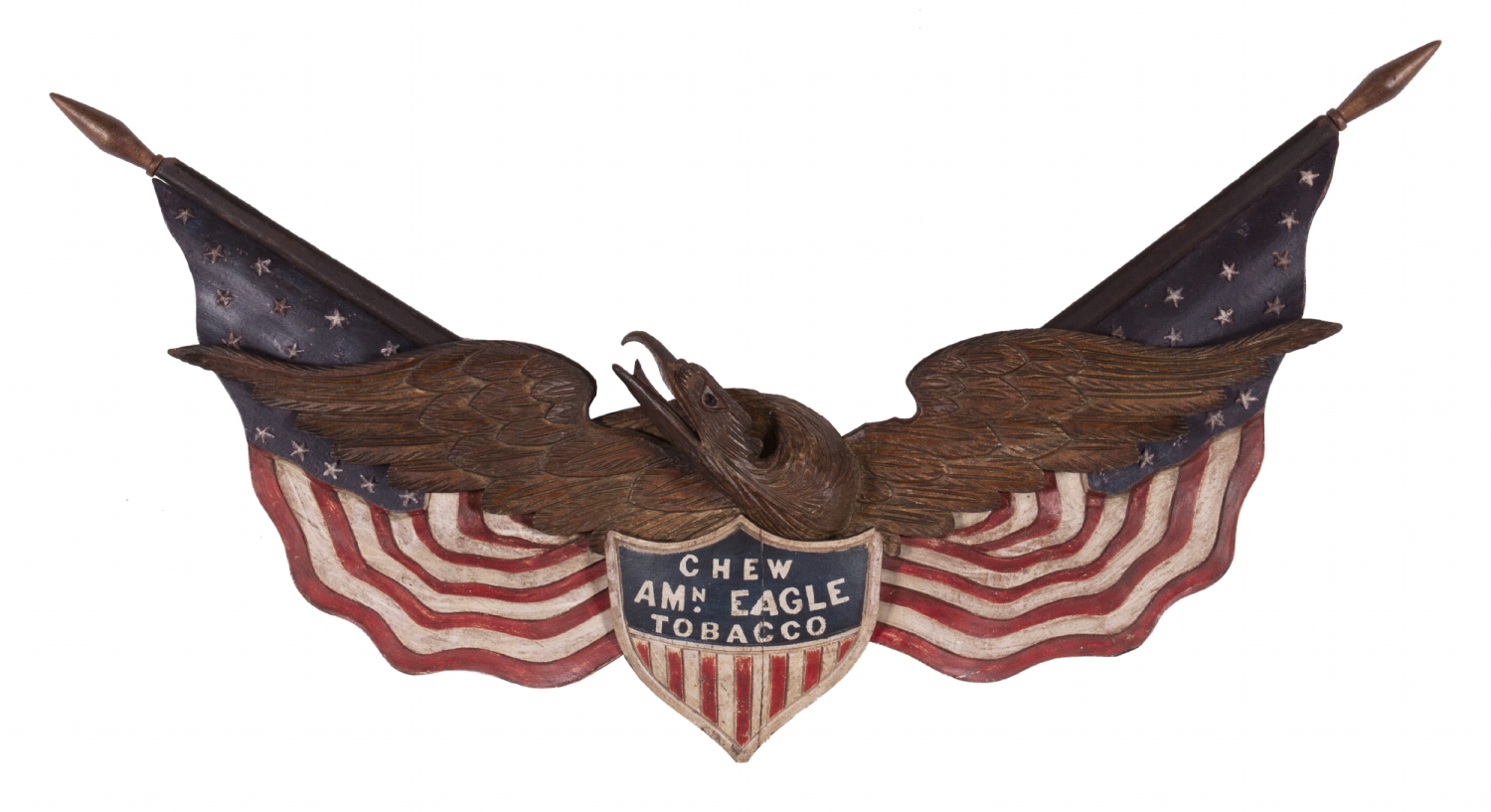
| |
CARVED EAGLE BY GEORGE STAPF, HARRISBURG, PENNSYLVANIA, AN EXCEPTIONAL EXAMPLE WITH TWO OUTSTRETCHED AMERICAN FLAGS AND A FEDERAL SHIELD, ONE OF JUST TWO KNOWN EXAMPLES WITH COMMERCIAL ADVERTISING, MADE CIRCA 1890-WWI |
| |
|
| Dimensions (inches): |
36.25" wide x 16" tall x 2.75” deep |
| Description: |
|
Patriotic eagle by Pennsylvania carver George Stapf (1862-1958) of Harrisburg, a carpenter who produced exuberantly stylized examples for Government buildings, and G.A.R. (Civil War veteran’s) halls, and others who commissioned his work.
Born in Columbia, PA in 1862, on the banks of the Susquehanna River, Stapf was the son of a German engineer. At some point he moved to Lancaster City, where he made candy and opened a confectionery. He was successful in this venture and sold a caramel recipe to Milton Hershey. Around 1890 he left the candy business behind for some reason and moved to Harrisburg, where he and his brother, John, opened a carpentry business. They built houses and buildings and George had a specialty in spiral staircases. One that he built survives today in the Dauphin County Historical Society.
Working in a shop behind his home at 47 W. 14th Street, he began in the winter during the 1890's to carve eagles, in order to supplement his income in the winter months when the climate got in the way of construction. He stopped around WWI (U.S. involvement 1917-18). He made various sizes, primarily in two basic styles, almost all of which, among recorded examples, grip federal shields in their talons and wrap elongated necks around the staff of waving Stars & Stripes flags.
This wonderful example is nearly unique among known designs. With two outstretched American flags that flank the spread-winged bird, and a shield below, this is one of just two that Stapf examples that survive with commercial advertising. Both carvings were apparently commissioned by the American Eagle Tobacco Company of Detroit, Michigan, I suspect for Pennsylvania locations where their products were sold.
Begun as K.C. Barker & Company in 1848, owner Kirkland C. Barker (1819-1875) closed the original firm and reopened under the American Eagle name at some point not long after. Born in Upstate, New York, Barker worked his way to Michigan via Cleveland and Indiana, eventually working as a traveling salesman for a tobacco firm. He soon went out on his own and would become both prosperous and influential. Among other things, he befriended George Custer, served as the Mayor of Detroit towards the end of the Civil War (1864-65), and was Commodore of the Great Lakes Yacht Club. By 1883 he was manufacturing almost 1.5 million tons of tobacco and sold to almost every city and town in the United States. With an office in NY and manufacturing in New Jersey, Barker and/or his representatives would have traveled through Harrisburg with some frequency. The firm was running full bore when Stapf was actively carving. At the turn of the century, United Cigar Stores—a huge distributor with stores throughout the U.S.—had two downtown locations in Harrisburg. These seem as likely candidates as not to have been the recipient of Stapf eagles advertising “Chew American Eagle Tobacco.” The Commonwealth of Pennsylvania commissioned huge examples, measuring between 6 and 8 feet in length, for the 1906 renovation of the state capitol, the dedication of which was attended by Theodore Roosevelt, who served as the keynote speaker.
Remarkably, until 20 years ago or so, Stapf was unknown to the antiques world. Because of the somewhat dragon-like elements present in his designs, some formerly thought these were China Trade eagles. Only recently were they identified to this Pennsylvania German working in the region from which some of the best American folk art originated. Stapf's interpretation probably had less to do with oriental influence and more to do with a rural carpenter's personalized, folk style rendering of the typical snake-head or turkey-head eagles, seen throughout the American colonial and federal periods.
The elongated head with its dramatic beak and tongue are signatures of Stapf's unique style and endeared by connoisseurs of American folk art. His carvings have great personality, are very desirable in the collecting community, and are far more rare than those of John Haley Bellamy of Maine, the most prolific eagle carver producing fairly similar, decorative designs.
Stapf passed in 1958 at the ripe old age of 96. The shop in which he carved no longer stands.
Condition: Overall excellent given the delicacy of the carving and usual state of known examples. There is a tiny amount of restoration at the extreme end of the beak, comprising no more than about 1/4". It has been suggested by another folk art expert that the two finials on the flag staffs might be replacements. Though they appear to be original, it is difficult to tell with absolute certainty and I felt it important to mention. Finials on Stapf eagles were often removable and therefore lost or damaged. |
|
|
| |
|
| Primary Color: |
red, white, blue, gold |
|
| Earliest Date: |
1890 |
|
| Latest Date: |
1918 |
|
| For Sale Status: |
Sold |
|
| Price |
SOLD |
|
| E-mail: |
info@jeffbridgman.com |
|
 |
|
Page Views:... 2446 |
|


